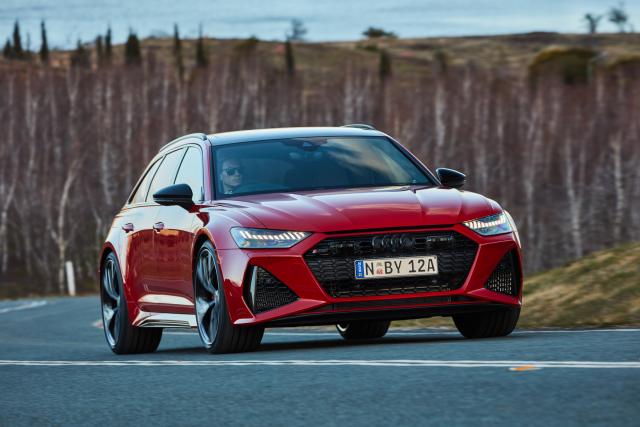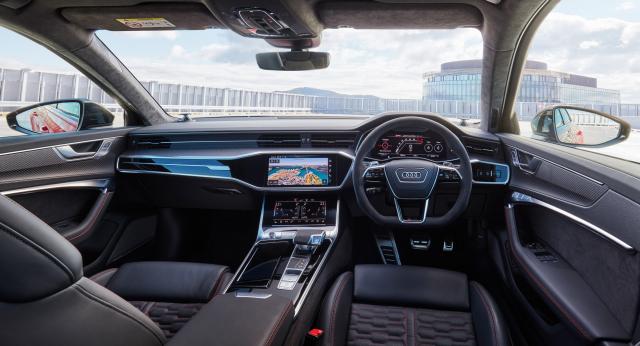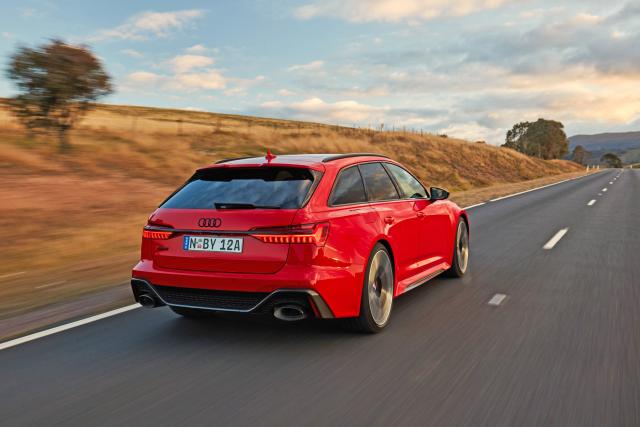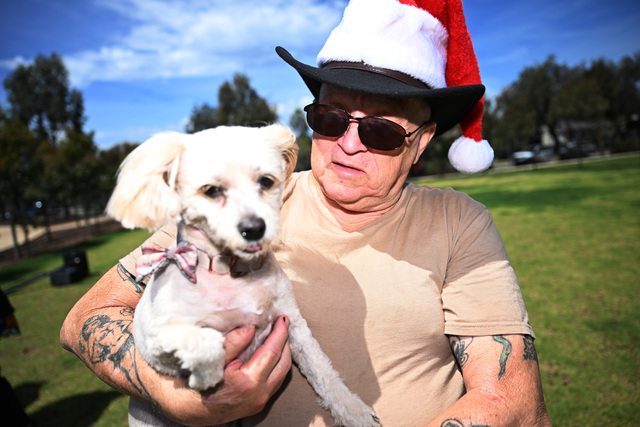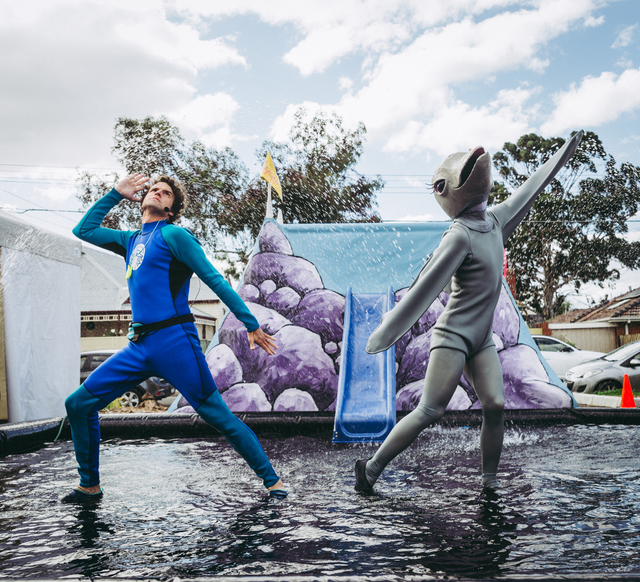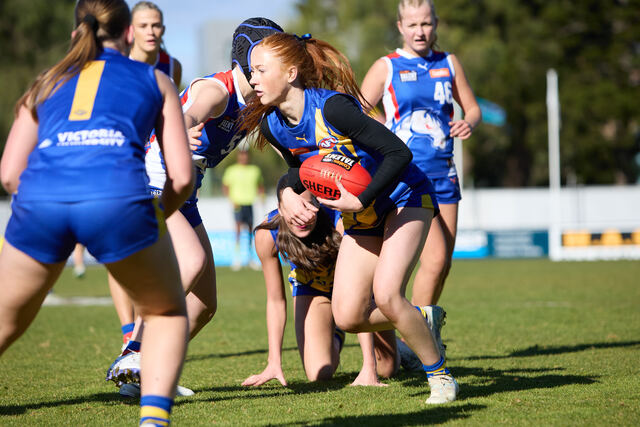Strewth! Audi’s RS 6 Avant is formidable. In fact, it’s almost too much car — correction, wagon.
It’s right up there in terms of the high-performance stuff that we’ve driven over the years and should not be underestimated.
I remember driving its little brother, the RS 4 Avant, on the track at Sydney’s Eastern Creek, one hand on the wheel, drifting effortlessly around a left-hander.
It was an amazing experience and I can only imagine RS 6 would be even more rewarding driven flat out in an environment that can accommodate its performance potential.
Competitors include the BMW M5 and Mercedes-AMG E63 — but they cost more and don’t offer the practicality of a wagon. SUVs need not apply.
STYLING
Sitting low to the ground, with pumped out guards and fat rubber, the look is understated, but you’d have to be Blind Freddy not to recognise this a vehicle that should be given a wide berth.
The wider single frame grille combines a black gloss finish with an RS-specific honeycomb structure, edged by arresting air inlets that sit below the standard HD Matrix headlights (with front and rear dynamic indicators).
Audi laser lighting technology further enhances the sophisticated lighting system by doubling the range of vision when travelling at speeds of more than 70km/h.
Distinctive 22-inch Audi Sport alloys are standard, with the striking red brake calipers and 285/30 series Hankook Ventus S1 Evo 3 rubber.
RS 6 Avant sits at the pointy end of the RS performance range, priced from $232,200 plus on-roads.
Its partner in crime, the RS 7 Sportback, which shares the same twin turbo V8 drivetrain, is another $8000.
It’s a lot but still considerably less than the S8 that we drove recently (our Lotto car) which is a nosebleed $273,000 — and not as quick.
Several option packs are also available, including a sensory package, the carbon and black styling package and the RS Dynamic package plus (with ceramic brakes and raised 305 km/h speed limit).
Our test vehicle was fitted with the $2900 RS Design Package, with $1700 Inlays in carbon twill and $700 gloss black Audi rings and badges, bringing the total price to $237,500.
Exterior highlights include the black exterior styling package, panoramic glass sunroof and metallic paint.
Inside, the cabin is upholstered in Nappa leather, while the RS sport front seats are finished in Valcona leather and feature full electric adjustment, heating and lumbar support.
Comfort items include convenience key, electric tailgate, electric/heated/folding mirrors, privacy glass, power-assisted door closure and electric steering column adjustment.
A selection of eight exterior colours are available with the addition of a new crystal effect paint in Sebring black, as well as a striking matt effect paint finish via Audi exclusive.
RS 6 is covered by a 5-year warranty, 5-year roadside assistance, plus a 12-year manufacturer warranty against corrosion.
Service intervals are 12 months or 15,000km.
INFOTAINMENT
Infotainment and connectivity is a strong point including MMI navigation plus with MMI touch response (dual touchscreens), Audi connect plus, Audi virtual cockpit, Audi smartphone interface with wireless Apple CarPlay.
There’s also wireless smartphone charging, 4x USB outlets located in the front and rear, DAB+ digital radio and a 705-watt Bang & Olufsen 3D sound system with 16 speakers.
ENGINES / TRANSMISSIONS
Motivation comes from a 4.0-litre twin turbo V8 that develops 441kW of power and a seriously impressive 800Nm of torque, the latter available across a wide band from 2050-4500 rpm.
Torque is distributed to all four wheels via a fast-shifting eight-speed Tiptronic-style transmission.
The V8 is underpinned by a 48-volt mild-hybrid electrical system that can recover up to 12kW of power while coasting or under light throttle.
The start/stop system also draws on the 48v system and functions at speeds up to 22 km/h, saving up to 0.8 litres of fuel per 100km.
Additionally, cylinder on demand (COD) technology can shut down four cylinders under light throttle application, resuming within milliseconds when required.
SAFETY
The full suite of available Audi driver assistance systems is fitted as standard including Adaptive cruise assist with Stop&Go and traffic jam assist, active lane assist and 360-degree cameras with kerb view.
Additionally, tyre pressure monitoring, an alarm and anti-theft wheel nuts with loose wheel detection provide peace-of-mind.
DRIVING
Have you seen the new Top Gun movie? Well, think of the RS 6 as top gun of the Audi go-fast range of vehicles.
The wagon, remember it’s a wagon, can sprint from 0 to 100km/h in a Ferrari-quick 3.6 seconds and on to 200km/h in just 12 seconds, with a top speed limited to 280km/h.
Under normal conditions, torque is distributed in a 40:60 bias to the rear wheels.
Up to 85 percent of torque can be directed to the rear wheels in special circumstances, when drifting for example.
A Quattro sport differential provides added control, able to direct almost all rear axle torque to either wheel in particularly dynamic driving.
The standard system comprises steel brakes, with red 10-piston calipers and 420mm front discs, with 370mm at the rear.
But Aussie delivered cars get the $19,500 RS Dynamic package as standard which includes larger 440mm ceramic brakes, with a choice of colour for the calipers (grey, red or blue).
For the first time, RS 6 and RS 7 also benefit from all-wheel steering, enhancing both agility and stability, depending on the situation.
It sees the rear wheels turn in the opposite direction to the front wheels at low speeds, reducing the turning circle by up to a metre.
At higher speeds, they turn in the same direction as the front wheels to provide better handling and stability.
Adaptive air suspension is also fitted, with a greater range than before.
Dynamic Ride Control (DRC), which diagonally links the suspension hydraulically, is available as an option.
All of these dynamic systems, the Electronic Stabilisation Control (ESC) and the standard RS sports exhaust, are integrated through the Audi Drive Select system.
Two new drive modes — RS 1 and RS 2 — can be quickly accessed and configured for specific high-performance settings.
It all adds up to a car, correction wagon, that is very quick — very quick indeed.
Pull the transmission lever back a second time to engage sport mode, punch the accelerator and the RS 6 bellows and rockets forward, quickly reaching 160 clicks in the blink of an eye.
Braking is just as quick to match.
Steering is sharp but could be more communicative while grip and handling are excellent, but better suited to wider free flowing roads than tight, twisting mountain trysts.
You get all this with a ride that is super smooth, given the liquorice strip tyres, even on our shocking secondary roads.
While performance is brutal, the emphasis is clearly on refinement.
The sports seats are large and comfy, with generous rear legroom. Although there’s room for a third passenger in the back, it’s really set up to accommodate two.
Luggage capacity is 565 litres, or 1680 litres with the rear seats folded.
One blot in an otherwise blemish free copybook though. Because of the low ride height and aerodynamic embellishments, driveways should be approached with extreme caution. If in doubt, park it on the street.
With a 73-litre tank it drinks the good stuff, 98-strength premium unleaded.
Rated at 11.7L/100km, we were getting 14.1L/100km after close to 400km of driving.
SUMMING UP
It’s difficult not to remain unimpressed by the RS 6. It’s an amazing looking thing with gob-smacking levels of performance. Dare I say, it’s almost too much car.
Thank god for modern day electronics which will stop mug drivers from putting their cars in a ditch.

